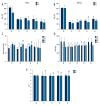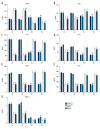Restrictive Fluid Resuscitation Leads to Better Oxygenation than Non-Restrictive Fluid Resuscitation in Piglets with Pulmonary or Extrapulmonary Acute Respiratory Distress Syndrome
- PMID: 26166324
- PMCID: PMC4514267
- DOI: 10.12659/MSM.892734
Restrictive Fluid Resuscitation Leads to Better Oxygenation than Non-Restrictive Fluid Resuscitation in Piglets with Pulmonary or Extrapulmonary Acute Respiratory Distress Syndrome
Abstract
Background: Early goal-directed therapy (EGDT) is used to reduce mortality from septic shock and could be used in early fluid resuscitation of acute respiratory distress syndrome (ARDS). The aim of the present study was to assess the effects of restrictive (RFR) and nonrestrictive fluid resuscitation (NRFR) on hemodynamics, oxygenation, pulmonary function, tissue perfusion, and inflammation in piglets with pulmonary or extrapulmonary ARDS (ARDSp and ARDSexp).
Material and methods: Chinese miniature piglets (6-8 weeks; 15 ± 1 kg) were randomly divided into 2 groups (n=12/group) for establishing ARDSp and ARDSexp models, and were further divided into 2 subgroups (n=6/subgroup) for performing RFR and NRFR. Piglets were anesthetized and hemodynamic, pulmonary, and oxygenation indicators were collected at different time points for 6 hours. The goal of EGDT was set for PiCCO parameters (mean arterial pressure (MAP), urine output and cardiac index (CI), and central venous oxygen saturation (ScvO2).
Results: Piglets under RFR had lower urine output compared with NRFR, as well as lower total fluid volume (P<0.05). EVLW was decreased in ARDSp+RFR and NRFR, as well as in ARDSexp+RFR, but EVLW increased in ARDSexp+NRFR (P<0.05). PaO2/FiO2 decreased in ARDSp using both methods, but was higher with RFR (P<0.05), and was increased in ARDSexp+RFR. Other pulmonary indicators were comparable. The anti-inflammatory cytokines IL-10 and LXA4 were increased in ARDSexp after RFR (P<0.05), but not in the other groups.
Conclusions: RFR led to better oxygenation in ARDSp and ARDSexp compared with NRFR, but fluid restriction improved oxygenation in ARDSexp only.
Figures



Similar articles
-
[Comparative study of recruitment maneuver guided by pressure-volume curve on respiratory physiology and lung morphology between acute respiratory distress syndrome of pulmonary and extrapulmonary origin in canine models].Zhongguo Wei Zhong Bing Ji Jiu Yi Xue. 2011 Jan;23(1):36-9. Zhongguo Wei Zhong Bing Ji Jiu Yi Xue. 2011. PMID: 21251365 Chinese.
-
[Effects of lung protective ventilation on inhibiting inflammatory mediators released into plasma and bronchial alveolar lavage fluid in acute respiratory distress syndrome caused by pulmonary and extrapulmonary insults in dog].Zhongguo Wei Zhong Bing Ji Jiu Yi Xue. 2004 May;16(5):262-6. Zhongguo Wei Zhong Bing Ji Jiu Yi Xue. 2004. PMID: 15132786 Chinese.
-
Effect of high frequency oscillatory ventilation on EVLW and lung capillary permeability of piglets with acute respiratory distress syndrome caused by pulmonary and extrapulmonary insults.J Huazhong Univ Sci Technolog Med Sci. 2015 Feb;35(1):93-98. doi: 10.1007/s11596-015-1395-4. Epub 2015 Feb 12. J Huazhong Univ Sci Technolog Med Sci. 2015. PMID: 25673200
-
Pulmonary and extrapulmonary acute respiratory distress syndrome are different.Eur Respir J Suppl. 2003 Aug;42:48s-56s. doi: 10.1183/09031936.03.00420803. Eur Respir J Suppl. 2003. PMID: 12946001 Review.
-
Is the mortality higher in the pulmonary vs the extrapulmonary ARDS? A meta analysis.Chest. 2008 Jun;133(6):1463-1473. doi: 10.1378/chest.07-2182. Epub 2007 Nov 7. Chest. 2008. PMID: 17989150 Review.
Cited by
-
Sequential Organ Failure Assessment predicts outcomes of pulse indicator contour continuous cardiac output-directed goal therapy: A prospective study.Medicine (Baltimore). 2017 Sep;96(39):e8111. doi: 10.1097/MD.0000000000008111. Medicine (Baltimore). 2017. PMID: 28953635 Free PMC article.
-
Genetic Polymorphisms of SP-A, SP-B, and SP-D and Risk of Respiratory Distress Syndrome in Preterm Neonates.Med Sci Monit. 2016 Dec 24;22:5091-5100. doi: 10.12659/msm.898553. Med Sci Monit. 2016. PMID: 28011976 Free PMC article.
-
Critical hemodynamic therapy oriented resuscitation helping reduce lung water production and improve survival.Chin Med J (Engl). 2019 May 20;132(10):1139-1146. doi: 10.1097/CM9.0000000000000205. Chin Med J (Engl). 2019. PMID: 30882456 Free PMC article.
-
Study on the Relationship Between Respiratory Distress Syndrome and SP-A1 (rs1059057) Gene Polymorphism in Mongolian Very Premature Infants.Front Pediatr. 2020 Mar 17;8:81. doi: 10.3389/fped.2020.00081. eCollection 2020. Front Pediatr. 2020. PMID: 32257981 Free PMC article.
References
-
- Ballard-Croft C, Wang D, Sumpter LR, et al. Large-animal models of acute respiratory distress syndrome. Ann Thorac Surg. 2012;93:1331–39. - PubMed
-
- Bernard GR, Artigas A, Brigham KL, et al. The American-European Consensus Conference on ARDS. Definitions, mechanisms, relevant outcomes, and clinical trial coordination. Am J Respir Crit Care Med. 1994;149:818–24. - PubMed
-
- Rubenfeld GD, Caldwell E, Peabody E, et al. Incidence and outcomes of acute lung injury. N Engl J Med. 2005;353:1685–93. - PubMed
-
- Montgomery AB, Stager MA, Carrico CJ, Hudson LD. Causes of mortality in patients with the adult respiratory distress syndrome. Am Rev Respir Dis. 1985;132:485–89. - PubMed
-
- Estenssoro E, Dubin A, Laffaire E, et al. Incidence, clinical course, and outcome in 217 patients with acute respiratory distress syndrome. Crit Care Med. 2002;30:2450–56. - PubMed
Publication types
MeSH terms
Substances
LinkOut - more resources
Full Text Sources

